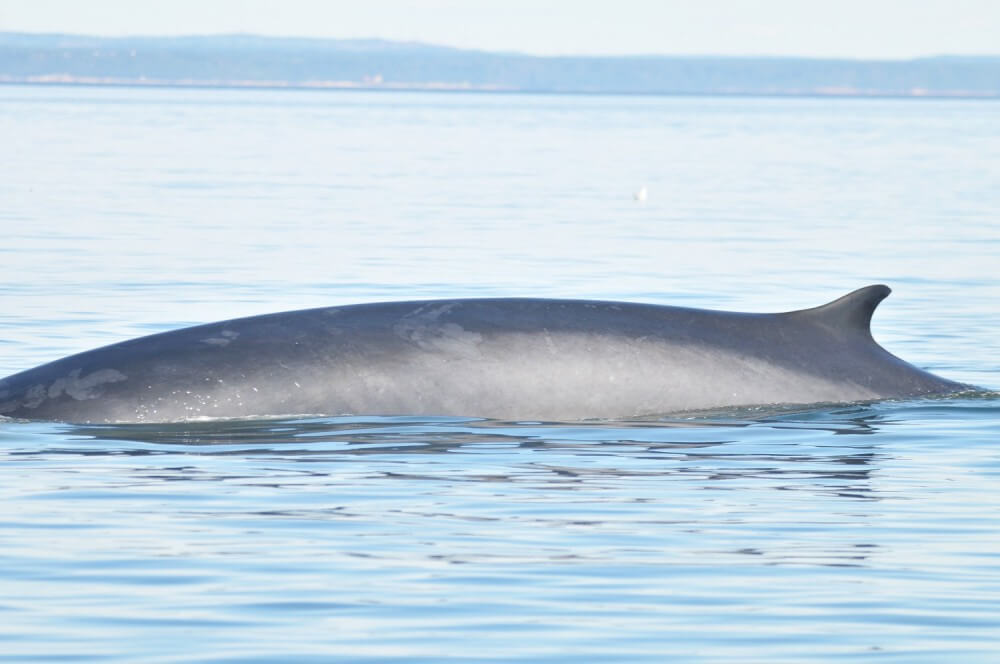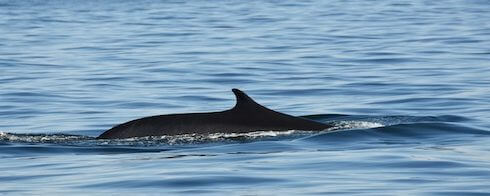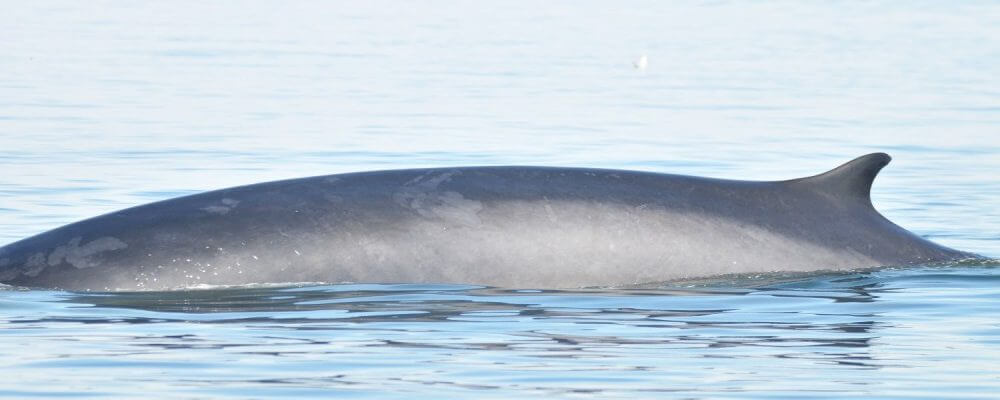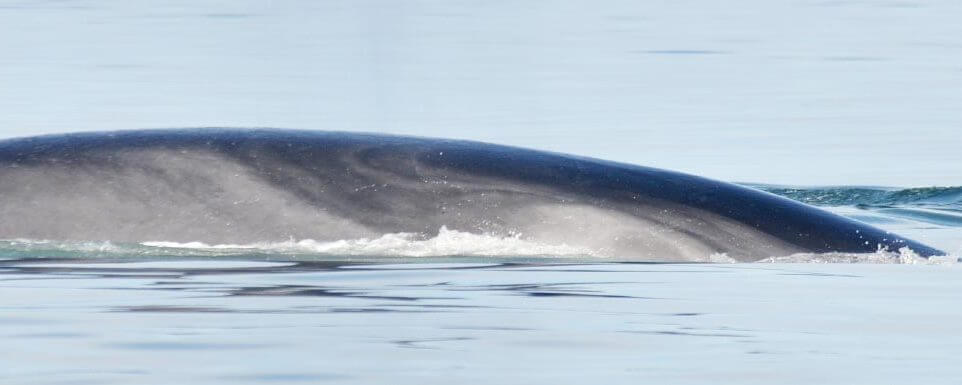Orion
Fin Whale


-
ID number
Bp017
-
Sex
Male
-
Year of birth
Unknown
-
Known Since
1988
Distinctive traits
Orion takes his name from the marks evoking the constellation on his right chevron. Once clearly visible, these markings have faded over time.
The tip of his V-shaped dorsal fin is a little damaged. It also has a notch and a small hump. Short white lines and an apostrophe-shaped depression can also be seen near his dorsal fin, on the right side.
Although he doesn’t often show this part of his body, Orion sometimes reveals a scar at the end of his peduncle, on the left side, which appeared in 2012.
Life history
On July 10, 2013, aboard the Bleuvet, a team composed of researchers from GREMM and Fisheries and Oceans Canada tagged a fin whale with a telemetry beacon. The aim of this project was to understand where, when, and how whales feed in the marine park. At the same time, the Parks Canada team, aboard the Alliance, conducted a census of prey in the areas frequented by the tracked whale. Orion led the team well downstream from the marine park; fortunately, the tag held up until late in the evening!
At noon on July 11, the team spotted the signal from the tag, which had finally detached from the whale’s back. All that remained was to retrieve it to download the data and study Orion’s underwater behavior.
Orion may have visited the estuary more often than his record suggests. Due to the subtlety of the markings that allow him to be identified, he may have gone unnoticed on a few occasions. In fact, there is some doubt about certain years, notably 1986, 1997, 1998, 2000, and 2011.
Observations history in the Estuary
Years in which the animal was not observed Years in which the animal was observed
Latest news from the publications Portrait de baleines
First identified this year on May 21, Orion only reappeared in the estuary on September 15. Where was he between these two dates? A mystery! His return last May ended a period of two seasons without his presence being reported in the Saguenay-St. Lawrence Marine Park. The rather pronounced notch at the bottom of his dorsal fin is thought to have appeared during this absence. A regular visitor to the estuary, Orion was biopsied and tagged several years ago, making it possible to determine his sex and track his feeding habits.
During his last season in the estuary, in 2021, Orion was caught by the GREMM research team breaching! Surprising behavior, since fin whales don’t tend to take their bodies out of the water as frequently as humpback whales do. A study of the fin whale population in the Mediterranean reported that only 3.74% of observations made by scientists involved breaching. The amount of energy required by these animals to project themselves out of the water would be equivalent to that of a 60 kg person running a marathon. Known since 1986, Orion was at least 35 years old at the time of this extraordinary jump!
Orion is a regular visitor to the St. Lawrence Estuary. First identified in 1986, this fin whale has been photographed in the Estuary almost every year since 1990. He has only been missed in 2002, 2005, and now possibly this summer. In fact, like several other fin whales that usually visit the Saguenay-St. Lawrence Marine Park every year (Caïman, Piton, Zipper…), this male, at least 36 years old, has yet to be seen this season.
Last year, Orion arrived in the Estuary in mid-July and was seen regularly until mid-September. His long stays in the Marine Park make him a “seasonal resident” of the region, and his absence does not go unnoticed. Many captains and naturalists complain that there are fewer great whales in the region this year. As for humpback whales, the usual stars (Siam, Tic Tac Toe, Gaspar, Irisept…) have been counted, but they don’t seem to be around for very long.
Orion may have flown by earlier this summer without being identified, but the absence of several other fin whales suggests that he simply hasn’t yet found a reason to head back down to the estuary to feed. That could yet change – it’s only mid-season!
Orion (Bp017) has a new mark this year that distinguishes him quite quickly from other fin whales present in the Marine Park: on his dorsal fin, a relatively deep, crescent-shaped notch. Orion is also recognizable by its dorsal fin, the tip of which is shaped like a truncated letter “V”. His subtle marks make this individual a rather discreet visitor, which means that he may have been seen more often than was officially noted. With his new marking, Orion will be easier to identify. Orion is a male fin whale that has been known since 1988. Its sex was determined in 2006 through a biopsy. He owes his moniker to the marks – now harder to discern – that resemble the constellation of the same name.
In 2013 he was tracked using radio-telemetry. With the first tag, he was tracked for four hours while he fed in the waters around Buoy K54. Researchers were able to tally 32 dives, including one down to a depth of 109 m. In one dive that lasted 11 minutes, Orion took 9 gulps. The record depth recorded by a fin whale is 230 m.
Last week, we were able to observe several spouts offshore, with columns over 5 m high. Four fin whales were feeding. Although fin whales are considered to be rather solitary, rather impressive groups are sometimes formed in the species’ highly productive feeding grounds in the Arctic. Some observers still recall the dozens of fin whales gathered in the St. Lawrence Estuary, feeding by coordinating each of their movements in unison. In baleen whales, associations between individuals of the same species, with the exception of mothers and their calves, are quite rare and short-lived. The can, however, sometimes be observed in groups during hunting or breeding activities. For example, in Alaska, multiple humpbacks gather to circle schools of herring. There are various possible explanations for this phenomenon: competition, cooperation, access to a reproductive partner, protection of young, etc. The precise reason for these congregations of fin whales in the Estuary remains poorly understood.
Orion is a fin whale that often frequents the St. Lawrence Estuary. Once clearly visible, the markings evoking the constellation Orion, which gave the whale his name, have faded over time. The tip of his dorsal fin is “trimmed” on both the top and bottom, making him easy to distinguish from other fin whales. Since 2012, Orion has been wearing a new mark, a scar on the peduncle that is visible from both flanks.
On July 13, several fin whales were in the vicinity of buoy K54. Orion and Bp913 are swimming in the melee. Bp913 is tagged with a radio beacon by the Fisheries and Oceans Canada-GREMM research team as part of the large whale monitoring project: 4 h feeding in the K54 buoy area and 32 dives to a depth of 109 m. During an 11-minute dive, he took 9 bites. On July 10, 2013, Orion had also been tagged by this team. He had dragged them well downstream of the marine park, and the beacon had held out well into the evening. The beacon signal, finally detached, had been found the next day around noon. The team was finally able to get their hands on it and discover the animal’s movements underwater.
 Result of Bp913’s dive. Depth in blue, speed in green. Speed peaks mean that speed is dropping and the animal is taking a bite.
Result of Bp913’s dive. Depth in blue, speed in green. Speed peaks mean that speed is dropping and the animal is taking a bite.
Radio telemetry is ideal for understanding the details of a whale’s underwater life in the estuary and tracking its daily movements. To study movements over longer distances, beacons using the ARGOS satellite network are used. The research technique of telemetric tracking has been used on fin whales for over a decade. It has highlighted dives at different depths (from below the surface to 230 m), with profiles linked to various activities (day and night, movement, rest, exploration, feeding).
On July 10, aboard the Bleuvet, a team composed of GREMM and Fisheries and Oceans Canada researchers placed a telemetry tag on the fin whale Orion. This project aims to understand the where, when, and how of the diets of whales in the Marine Park. The Parks Canada team, from aboard L’Alliance, conducts the prey census in parallel in the sectors utilized by the monitored whale. Orion steered the team well downriver of the Marine Park, and the tag was still holding late into the evening… At the time of writing – July 11, noon – the team had picked up the tag signal again, which had finally fallen off the animal’s back. All that was left to do was retrieve it and download the data!
As soon as the tag had been placed, the field team emailed photos of the whale to the GREMM research station. Mission: find out which individual it is. Not so easy! Photo-identification is successfully employed to study numerous species of cetaceans by following the individual histories of whales recognizable by their natural marks. But this method represents a considerable challenge when applied to fin whales, which exhibit few reliable marks to distinguish them from one another and to recognize them from one sighting to the next.
That said, here’s how we recognize Orion: small circles (now somewhat less pronounced) on the right side of her head, a somewhat damaged dorsal fin tip, short white lines and a comma-shaped depression distinguishable on her right side near the dorsal fin and, ever since an injury she sustained last year, a scar on the peduncle, a body part that she unfortunately does not often show…
Orion has perhaps been present more often than this list would lead to believe. The marks researchers rely on to identify her are subtle enough that she could go unnoticed. Moreover, uncertainty remains concerning certain years, notably 1986, 1997, 1998, 2000 and 2011.
During initial encounters with the GREMM team, this fin whale bore markings in his right chevron: four circles recalling the position of the stars in the constellation Orion (the hunter of Greek mythology). But these markings gradually faded. Other characteristics, notably on the dorsal fin, now make him possible to identify. But it’s not easy with the naked eye or when the whale is on the move. Identifying a fin whale requires a series of high-quality photos covering different parts of the animal’s body… and a trained eye. In the case of Orion, doubt still hangs over photographs taken in certain years: 1986, 1997, 1998 and 2000.
Orion was photographed on June 24 in the area of the head of the Laurentian Channel.
With a biopsy, a few milligrams of fat and skin are removed from the animal’s back. From the skin sample, the DNA of the individual is extracted: this is its genetic signature. It’s a mine of information for biologists, who can use it to determine whether the animal is male or female. Fat is also used in chemical analysis to detect the presence and level of contaminants.




